Op-Ed| The Douglas Fir National Monument Proposal
By George Wuerthner
Some of the most spectacular forests of Douglas fir in the West are found on the west slope of the Cascade Mountains in Oregon. Though heavily logged by the timber industry for its straight-grained wood over the years, some important examples of these once-extensive old-growth forests can still be found in western Oregon.
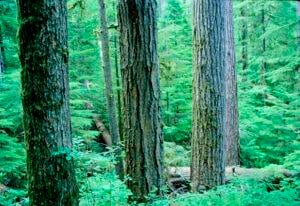
Mature Douglas Fir forest along Middle Santiam River/George Wuerthner
The Friends of the Douglas Fir National Monument is working to preserve all the remaining old-growth stands on federal lands in the North, Middle, and South Santiam watersheds. A map of the current proposal boundaries can be found here. On lands previously logged and turned into plantations, restoration forestry would seek to restore the forests and eventually preclude the logging of these areas.
Unlike a national park, which only Congress can designate, a national monument can be created by executive decree of a president under the 1906 Antiquities Act. Designation of a Douglas Fir National Monument by President Biden would help achieve several of the president’s stated goals of protecting 30 percent of the American land base by 2030 and meeting climate change targets by preserving the best carbon storage “machines” we have—old growth forests.
Previous efforts to preserve specific vegetation as national monuments or parks include the Giant Sequoia National Monument, Sequoia National Park, Joshua Tree National Park, Saguaro National Park, and Organ Pipe Cactus National Monument.
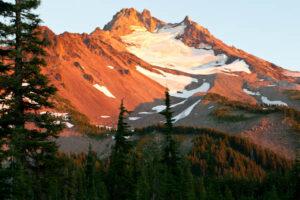
Mount Jefferson in Mount Jefferson Wilderness/George Wuerthner
Some of the area’s old-growth forests are currently preserved in the Mount Washington, Menagerie, Mount Jefferson, and Middle Santiam wildernesses within the Douglas Fir National Monument proposal. However, many stands are threatened by logging and their continued existence as intact ecosystems is not assured. For instance, the Sweet Home Ranger District recently unveiled the Quartzville-Middle Santiam timber sale that would affect 7,900 acres. Fortunately the U.S. Forest Service, after hearing objections from the Friends and other organizations, has withdrawn the sale for now.
The Douglas Fir (Pseudotsuga menziesii) is named for Scottish botanist David Douglas, who first explored and documented the trees in western Oregon. Douglas wrote of the western Cascades forests, “A forest of these trees is a spectacle too much for one man to see.”
Douglas traveled extensively in western North America between 1825 and 1830, and more than 80 species of plants bear his name. But the one species that most impressed Douglas was the mighty tree that is only second to redwood in height and girth.
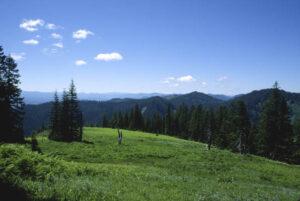
View of subalpine meadow on Brower Ridge within the proposed national monument/George Wuerthner
Mature Douglas fir can reach heights of 300 feet and 10 feet in girth. In addition, Douglas-fir can live for 1,000 years, earning the moniker “old growth” or “ancient” forest. Representative examples of these ancient forests can be found in and around the Middle Santiam Wilderness, Crabtree Valley, and Millennium Grove near Gordon Meadows within the proposed national monument.
The 702,000-acre proposed national monument would have numerous benefits for ecosystem health.
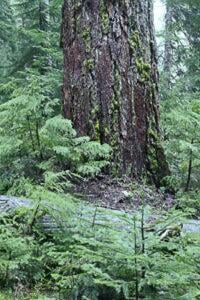
Mature old growth Douglas fir/George Wuerthner
First, it would preserve the last great stands of Douglas fir and associated species found along a sizeable portion of the Oregon Cascades. Old-growth forests have long been recognized as critical for numerous species of wildlife from the spotted owl to important spawning and rearing habitat for salmon.
These giants store incredible amounts of carbon, thus contributing to carbon storage. By precluding the logging of these virgin stands, the national monument would ensure that carbon will continue accumulating in the growing trees and the large woody debris (down logs) that characterize the ancient forests.

Old growth Douglas fir continue to store carbon throughout their long lives up to an age of 1000 years/George Wuerthner
Contrary to some assertions, mature and old-growth forests continue to store carbon throughout their lives. Once they die, the snags and large down trees (what biologists term down woody debris) continue to store carbon for centuries. By contrast, logging removes the carbon from the forest storehouse and releases much of it into the atmosphere.
Logging old-growth forests releases nearly 60 percent of their stored carbon into the atmosphere as carbon dioxide. Indeed, in Oregon, 35 percent of the carbon emissions in the state are attributed to the timber industry.
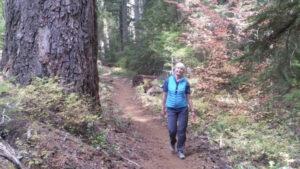
Representative old growth forest along the Upper McKenzie River within the proposed Douglas Fir National Monument/George Wuerthner
Indeed, in a recent 2021 paper, a number of prominent scientists called for creating strategic reserves to preserve and protect forest carbon. One of the study’s authors, Bev Law, was surprised to find that only 10 percent of Oregon’s forests are protected at the highest levels such as official wilderness or national parks, which restrict extractive activities such as mining and logging.
Despite its reputation as a “progressive” state, another recent study found that Oregon has protected the lowest percentage of protected forestlands of any Western state. The proposed Douglas Fir National Monument would go a long way toward protecting some of Oregon’s most carbon-rich forests.
From a climate change point of view, the best thing we can do is to preserve old-growth forests intact and to allow previously logged areas to regrow into mature forests.
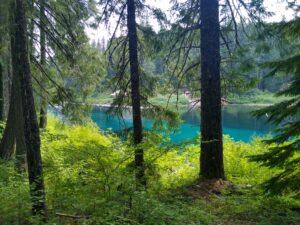
Clear Lake at the Upper McKenzie River within the proposed Douglas Fir National Monument/George Wuerthner
The monument proposal takes its name from the dominance of the giant Douglas fir; however, the area supports one of the finest examples of Western conifer forests to be found anywhere, including Western red cedar, Western white pine, noble fir, Pacific silver fir, grand fir, sugar pine, ponderosa pine, Alaska cedar, western hemlock, mountain hemlock, Engelmann spruce, lodgepole pine, and subalpine fir.
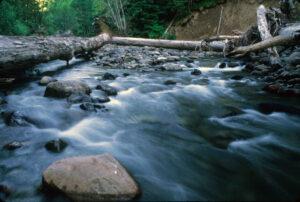
Middle Santiam River, one of numerous rivers proposed for Wild and Scenic status within the Douglas Fir National Monument/George Wuerthner
The Douglas Fir National Monument proposal would also protect some of the finest waterways in western Oregon, many supporting salmon, bull trout, and native cutthroat trout, among other species. A portion of Quartzville Creek is designated as a Wild and Scenic River. Most of the remaining significant streams and rivers in the proposal are included in the River Democracy Act of 2021, which would protect them under the Wild and Scenic Rivers Act. You can see the proposed monument's rivers nominated for inclusion in the Act here.
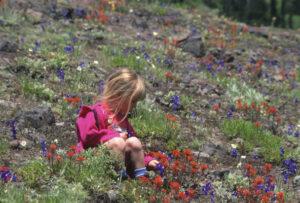
Subalpine meadows abound in wild flowers/George Wuerthner
The monument would ensure that these watersheds would heal from past logging abuses and continue to provide clean water essential for healthy aquatic ecosystems, salmon, and recreation. Plus, drinking water for many Willamette Valley communities. Numerous recreational opportunities for hiking and camping exist within the proposed monument. Go to this link to read Q and A about the monument proposal that responds to numerous issues.
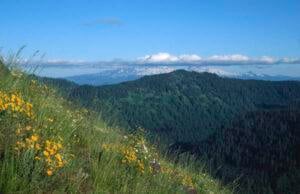
The “Old Cascades” from Echo Peak Basin/George Wuerthner
To learn more about the numerous special places within the proposal, check out this link.
I only have one quibble with the proposal; it should be larger, including the upper Willamette River and its tributaries on the McKenzie and Middle Fork ranger districts, extending south to the Umpqua River divide.
You can connect with Friends of the Douglas Fir National Monument here or on Facebook.

 Support Essential Coverage of Essential Places
Support Essential Coverage of Essential Places



